Opiate Addiction Rehab
Opiate addiction has become a serious issue around the world. More people develop opiate addiction in the United States every year. Many times, the problem starts with prescription pain pills abuse and escalates to heroin abuse once the prescriptions are no longer available, creating the need for opiate addiction rehab and treatment. Get more insight into this epidemic and why treatment is so important.
Understanding Opiates
Opium is derived from the poppy plant. People use this natural drug to make both illegal and legal opiates. The illegal form is heroin, while painkillers are legal, as long as individuals have a prescription. Examples of common prescriptions include morphine, OxyContin, Percocet and Vicodin.
Opiates bind to receptors in the brain, causing it to release a flood of dopamine. This natural chemical affects many functions in the body, such as memory, movement and learning. Triggering pleasure is its most notable role and what typically causes people to develop an opiate addiction.
Over time, the brain loses the ability to make its own dopamine. It also begins to associate happiness with opiates. Due to these issues, the brain craves opiates when it doesn’t get its dose. Then the body responds with withdrawal symptoms.
Short-Term Opiate Effects
Opiates hinder how the body perceives pain, making them an effective form of pain treatment. They can also create a sense of euphoria, relaxation, and drowsiness. Physically, individuals who take opiates usually have small pupils. Pinpoint pupils are one of the major signs of opiate abuse because they’re hard to hide.
These effects last for different amounts of time depending on the type of opiate that people use. Heroin, for example, produces an intense high that lasts for 15 to 30 minutes. On the other hand, the effects of morphine last for 4 to 6 hours. However, the drugs actually stay in the body for much longer.
Opiate Addiction
Opiates have several negative long-term effects as well. Some of these include abdominal bloating, constipation and nausea. More serious side effects include brain and liver damage, as well as cardiac arrest or coma.
People with opiate addiction can’t stop using these drugs even if they want to. Their bodies crave the high levels of dopamine that opiates promote. They may get involved in criminal activity to buy more drugs. Their relationships and school or work performance also suffer because they make obtaining and using drugs a priority.
Opiate Withdrawal
When people with addiction try to stop taking opiates, they experience withdrawal symptoms. The most common are anxiety, muscle or joint aches, nausea and sweating. Many people also experience fatigue.
This process can last for 7 to 10 days, although some symptoms may last for months. Unfortunately, these symptoms can be so severe that people immediately turn to their drug of choice again for relief. Supervised medical detox at a rehab center is the safest and most successful way to begin addiction treatment.
Opiate Addiction Rehab and Treatment
After detox, the core of addiction treatment starts with addiction treatment therapy. People have to learn how to live without opiates and address the cause of their addiction and develop skills to avoid relapse.
It’s important for people with addiction to continue to get support even after rehab. They can get this from family members, support groups, and therapists. Their support network helps them stay sober.
Silver Pines Treatment Center Can Provide Opiate Treatment
- Trauma therapy
- Yoga
- Family therapy
- Outdoor activities
- Exercise





